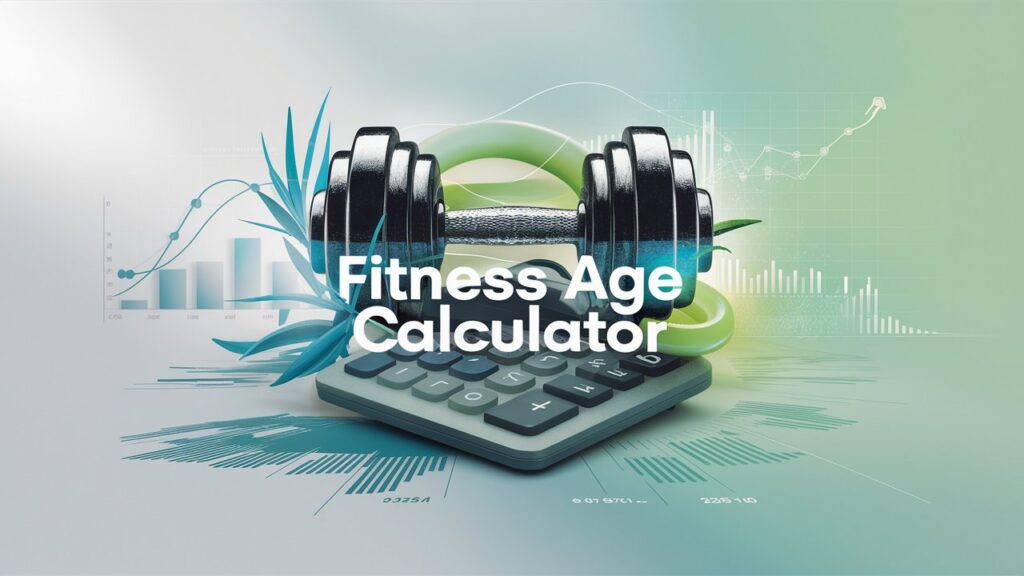Fitness Age with Our Easy Calculator!

Ever wondered how fit you truly are? Beyond just your appearance or how much you can lift, your overall fitness is a crucial indicator of your health. Enter the concept of Fitness Age—a metric that might surprise you! Unlike your chronological age, which is just a number based on your birthdate, your Fitness Age can give you a more accurate picture of your physical condition. In this article, we’ll explore the ins and outs of Fitness Age, why it matters, and how you can calculate yours with ease using our simple Fitness Age Calculator.
Understanding Fitness Age
|Calculate Your Age Here |
Advanced Fitness Age Calculator
Fitness Age is a concept that represents how old your body is biologically, based on your fitness levels rather than the number of candles on your birthday cake. It’s a holistic measure that considers factors like cardiovascular endurance, strength, flexibility, and body composition.
The Science Behind Fitness Age
The idea of Fitness Age is grounded in research that links physical fitness with overall health. Scientists have found that certain markers, such as your resting heart rate, VO2 max (the maximum amount of oxygen your body can use during intense exercise), and muscle mass, can indicate your body’s biological age. If your fitness level is higher than average for your chronological age, your Fitness Age will be lower, suggesting a healthier, younger body.
|Other Easy Calculator|
Factors Affecting Fitness Age
Your Fitness Age is influenced by various factors, including:
- Cardiovascular Fitness: How well your heart and lungs supply oxygen during exercise.
- Muscular Strength and Endurance: The ability of your muscles to exert force and sustain repeated contractions.
- Flexibility: The range of motion around your joints.
- Body Composition: The proportion of fat and lean mass in your body.
Why Your Fitness Age Matters
Health Implications of Fitness Age
Your Fitness Age is more than just a fun number; it’s a powerful indicator of your overall health. Studies have shown that a lower Fitness Age is associated with a reduced risk of chronic diseases such as heart disease, diabetes, and certain cancers. It can also reflect your likelihood of living a longer, healthier life.
Fitness Age vs. Chronological Age
While your chronological age is fixed, your Fitness Age can be changed. This means that with the right lifestyle changes, you can actually “turn back the clock” on your body. In some cases, individuals have achieved a Fitness Age significantly younger than their actual age, which often corresponds to better health and vitality.
How Fitness Age Reflects Overall Well-being
Fitness Age encapsulates not just your physical capabilities but also your lifestyle habits. A lower Fitness Age suggests that you’re living in a way that supports long-term health, including regular exercise, a balanced diet, and effective stress management.
How to Calculate Your Fitness Age
Overview of the Fitness Age Calculator
Our Fitness Age Calculator is an easy-to-use tool that estimates your Fitness Age based on a few simple inputs. It’s designed to give you a snapshot of where you stand and offer insights into how you can improve.
Key Inputs Required
To calculate your Fitness Age, you’ll need to provide:
- Resting Heart Rate: This is the number of times your heart beats per minute while you’re at rest. It’s a key indicator of cardiovascular health.
- Exercise Habits: Information about how often you exercise and the intensity of your workouts.
- Body Measurements: Your weight, height, and waist circumference help determine your body composition.
Step-by-Step Guide to Using the Calculator
- Enter Your Resting Heart Rate: Measure it first thing in the morning for the most accurate result.
- Detail Your Exercise Routine: Be honest about your activity level to get a true reflection.
- Input Your Body Measurements: This includes your weight, height, and waist size.
- Calculate: Hit the button to see your Fitness Age and receive personalized tips for improvement.
Interpreting Your Fitness Age Results
What Does a Lower Fitness Age Mean?
If your Fitness Age is lower than your actual age, congratulations! This indicates that your body is in better shape than most people your age, which bodes well for your long-term health.
Understanding a Higher Fitness Age
A higher Fitness Age suggests that your body is biologically older than your chronological age. This might be a wake-up call to make some lifestyle changes, such as increasing physical activity or improving your diet.
How to Compare Your Fitness Age to Your Actual Age
To get the most out of your Fitness Age calculation, compare it to your chronological age. A significant difference between the two can highlight areas where you might need to focus more on your health and fitness.
Improving Your Fitness Age
Exercise Tips for Reducing Your Fitness Age
One of the most effective ways to lower your Fitness Age is through regular exercise. Here are a few tips:
- Incorporate High-Intensity Interval Training (HIIT): HIIT workouts are great for boosting cardiovascular fitness in a short amount of time.
- Lift Weights: Strength training helps build muscle mass and improves your metabolic rate.
- Stay Active Daily: Incorporate movement throughout your day, not just during workouts.
The Role of Diet in Fitness Age
What you eat plays a significant role in your Fitness Age. A diet rich in whole foods, such as fruits, vegetables, lean proteins, and healthy fats, can support a lower Fitness Age. Avoid processed foods, excessive sugar, and unhealthy fats to keep your body youthful.
Importance of Rest and Recovery
Don’t underestimate the power of rest. Proper sleep and recovery are crucial for your body to repair itself and perform at its best. Aim for 7-9 hours of quality sleep per night, and incorporate rest days into your fitness routine.
Consistency and Progress Tracking
Lowering your Fitness Age isn’t about quick fixes; it’s about consistent effort over time. Track your progress regularly, and celebrate small victories along the way.
The Role of Cardio in Fitness Age
Cardio Exercises and Their Impact
Cardiovascular exercise is a cornerstone of reducing your Fitness Age. It strengthens your heart and lungs, improving your overall fitness.
How Often Should You Do Cardio?
Aim for at least 150 minutes of moderate-intensity cardio per week. This could be spread out over several sessions, like brisk walking, cycling, or swimming.
Best Cardio Workouts to Lower Fitness Age
Some of the most effective cardio workouts include running, swimming, cycling, and rowing. These exercises elevate your heart rate and improve cardiovascular endurance, leading to a lower Fitness Age.
Strength Training and Fitness Age
Importance of Muscle Strength and Fitness Age
Muscle strength isn’t just for bodybuilders; it’s essential for everyone. Strong muscles support your joints, improve posture, and boost your metabolism—all of which can help lower your Fitness Age.
Effective Strength Training Routines
Incorporate a mix of compound exercises like squats, deadlifts, and push-ups with isolated movements such as bicep curls and tricep dips. Aim for 2-3 strength training sessions per week.
Balancing Cardio and Strength Training
Both cardio and strength training are important for reducing your Fitness Age. A balanced routine that includes both will give you the best results.
Flexibility and Mobility for a Better Fitness Age
Why Flexibility Matters
Flexibility is often overlooked, but it’s crucial for maintaining a youthful body. Good flexibility reduces the risk of injury and improves your overall movement quality.
Simple Stretches to Improve Flexibility
Incorporate daily stretches targeting all major muscle groups. Focus on areas like the hamstrings, quadriceps, hips, and shoulders.
Incorporating Mobility Drills into Your Routine
Mobility drills, like hip circles, arm swings, and ankle rotations, help improve joint flexibility and movement efficiency, contributing to a lower Fitness Age.
Mental Health and Fitness Age
The Connection Between Mental and Physical Health
Your mental health has a direct impact on your physical health. High stress levels can lead to a higher Fitness Age, as chronic stress affects your body’s ability to repair and rejuvenate itself.
Stress Reduction Techniques
Practice stress reduction techniques such as deep breathing, yoga, and spending time in nature to keep your mind and body in harmony.
Meditation and Mindfulness Practices
Meditation and mindfulness can lower stress levels, improve focus, and enhance your overall well-being, which can contribute to a lower Fitness Age.
Tracking Your Progress
How Often to Recalculate Your Fitness Age
It’s a good idea to recalculate your Fitness Age every 3-6 months. This gives you enough time to see the impact of any lifestyle changes you’ve made.
Monitoring Changes and Adjusting Your Routine
If your Fitness Age isn’t improving, it might be time to adjust your routine. Consider changing your workout intensity, trying new exercises, or focusing more on your diet.
Tools and Apps for Tracking Fitness Age
There are several apps available that can help you track your Fitness Age and overall health metrics. These tools can provide valuable insights and keep you motivated.
Common Misconceptions About Fitness Age
Myth: Fitness Age Is Only About Exercise
While exercise is a major factor, your Fitness Age is also influenced by your diet, mental health, sleep, and more. It’s a holistic measure of your overall health.
Myth: You Can’t Improve Your Fitness Age After a Certain Age
It’s never too late to improve your Fitness Age. With the right approach, people of all ages can lower their Fitness Age and enjoy better health.
Myth: Fitness Age Calculators Aren’t Accurate
While no calculator is perfect, our Fitness Age Calculator uses scientifically backed metrics to provide a reliable estimate of your Fitness Age. It’s a valuable tool for gauging your overall fitness level.
Success Stories
Real-Life Examples of People Who Lowered Their Fitness Age
Meet Jane, who managed to lower her Fitness Age by 10 years through consistent exercise and a balanced diet. Or Tom, who started strength training in his 50s and saw his Fitness Age drop by 8 years.
Inspirational Stories and Tips
These success stories highlight that anyone can improve their Fitness Age with dedication and the right strategies. Whether it’s small changes like walking more or big commitments like overhauling your diet, every step counts.
How Tracking Fitness Age Transformed Their Lives
For many, lowering their Fitness Age has led to not just better health, but also more energy, confidence, and a renewed zest for life.
Your Fitness Age is a powerful indicator of your overall health and well-being. It’s not just about how long you live, but how well you live. By understanding and improving your Fitness Age, you can take control of your health and work towards a younger, more vibrant body. Use our Fitness Age Calculator today to discover where you stand and get personalized tips to help you improve.
- Also Read :
- Sculpt Your Arms: Top 10 Best Arm Workouts to Try Today!
- Beginner TRX Workouts: Start Your Fitness Journey
- Discover the Best Kettlebell Workouts for All Levels
- Improve Your Swing with Golf Flexibility Exercises
- Core and Flexibility Workout for a Stronger Body
FAQ’S:
What is the ideal Fitness Age?
There’s no one-size-fits-all answer, but ideally, your Fitness Age should be close to or younger than your chronological age.
Can your Fitness Age be younger than your actual age?
Absolutely! With a healthy lifestyle, it’s possible to achieve a Fitness Age significantly younger than your chronological age.
How long does it take to lower your Fitness Age?
It varies for everyone, but with consistent effort, you might start to see changes in as little as 3-6 months.
Is Fitness Age affected by genetics?
Genetics can play a role, but lifestyle factors like exercise, diet, and stress management have a significant impact.
